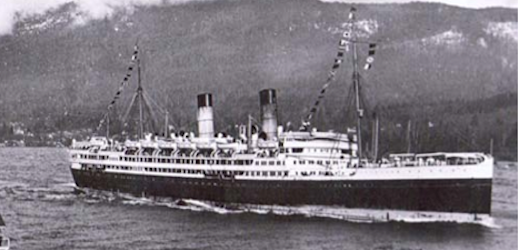RMS AORANGI

RMS AORANGI, said Victoria's Mayor Pendray, marked "another step in the supremacy, ever maintained, of British shipping over the Seven Seas." The Pacific Northwest said farewell to an old seafaring friend in February 1953 when mariners and landlubbers alike joined in paying tribute to the record-breaking passenger liner RMS Aorangi which had come to the end of an illustrious 28-year long career. After more than a quarter century of service, and more than a million miles in wartime and in peace, the Canadian-Australian "Grand Old Lady" was headed for the shipbreakers. The nostalgic news stories covering her final voyage from Vancouver recalled the historic day in January 1925 when AORANGI, proudly billed as the "world's largest motor ship" (as opposed to steam ship), visited Victoria on her maiden voyage.
"Completing her maiden voyage from Govan, Scotland, where she was built by the Fairfield Shipbuildings and Engineering Company," reported the Colonist, "the new Canadian-Australian liner Aorangi, the largest motor liner in the world, arrived May 23rd around noon at William Head quarantine station, and after securing pratique the vessel docked at Pier Two of Rithet's wharves, where she was open for inspection by the public, from 3 until 5 o'clock.
"At every port of call en route to Victoria, the AORANGI has been given a big reception and has proved herself the wonder ship of the world. Victoria will not be backward in its welcome to the liner, for arrangements have been made to give the passengers and Capt. Crawford, RNR, a royal time during their stay in this port. The vessel will remain here all night and sail for Vancouver at 6 o'clock, Friday morning, where she will go on berth to load for Australia, calling at Victoria again outbound for the Antipodes."
The newspaper recalled the "sensation" of 1922 when the Union Steamship Co. had ordered her from the builders, the largest existing motor vessel being less than 500 feet long and powered by engines capable of producing 4,500 bhp. AORANGI would be 600 feet overall, and 17,000 tons; during sea trials, her powerful engines achieved a remarkable output of 12,400 bhp on the measured mile.
However, the marine world was not long in following suit as diesel power became the choice of shipowners. AORANGI - "Cloud Piercer" in the Maori tongue - soon proved that her owners' optimism was well founded. Even during her trials in the stormy Irish Sea, she'd glided through the heaviest seas, her four propellers (another first) making up to 18 knots in calmer weather.
On the afternoon of Jan. 19, 1925, the shining new liner docked at Victoria's Outer Wharves, to be welcomed by Mayor J.C. Pendray who addressed Capt. Crawford and his officers: "We hail this event as an auspicious one, not only as an aid in the extension of commercial intercourse between two sister dominions of the empire, but also as a means of further cementing the present ties of kinship and friendship which exist, and as an assurance of sympathetic cooperation in the future. We have watched with interest the progress of this vessel on its maiden voyage and recognize the importance to the commercial world of a successful outcome to this new departure in...engineering. The advent of your ship to our shores marks but another step in the supremacy, ever maintained, of British shipping over the Seven Seas."
After Mrs. Pendray made a brief address and presented Capt. Crawford with a bouquet of flowers, daughter Dorothy proffered a second bouquet to Mrs. C. Holsworth, wife of the manger of the Union Steamship Co. Then the welcoming committee was given a guided tour of the ship. Civic dignitaries were not alone in welcoming AORANGI, that winter afternoon, hundreds of Victorians toured the handsome liner. All seem to have been dazzled by the "modern wonder of the shipping world...which has been so skillfully built that she appears more like a huge steam yacht than a passenger ship...and with her finely designed lines and handsome cruiser stern, her form is to be much admired."
Her owners had spared "practically no thought or expense...in the design and furnishings of her first class public rooms [which] combine the stately dignity of historical period decoration with the comfort and hygienic practices of the present day, and the standard set up recently by high class liners for luxurious comfort in travelling on deep sea voyages has been more than maintained in this new vessel by the wellproportioned and skillfully modelled architectur[al] detail of the rooms to meet the criticisms of the cultured traveller in their pleasing appearance and artistic appointments." AORANGI was, the Colonist's marine reporter almost whistled in appreciation, like a West End hotel.
If modern-day cruise ship travellers take AORANGI's appointments, and more, for granted, it should be noted that, 90 years ago, the motor vessel was the last word in luxury, labour-saving devices and appointments. But her real claim to fame was below decks where, deep in her engine room, her revolutionary Sulzer diesel engines, capable of thrusting her through the seas at 18 knots with "a complete absence of vibration," were positioned. AORANGI was designed to carry 380 first class passengers, 281 in second class, and 227 in third class, with a crew of 328. All this came to an end in 1951 but the onetime wonder ship, by then tired, was given a two-year reprieve. In her 28-year- long career, RMS AORANGI had circumnavigated the globe 32 times.
Source : The Citizen / Canada / Postmedia News
